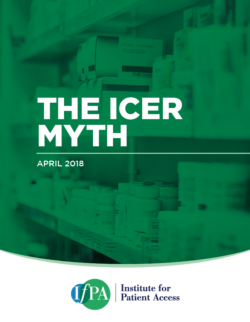 What is innovative medicine worth to patients? It depends on which patient you ask. The disease a patient suffers from, its symptoms and their impact on a patient’s day-to-day life make the question a highly personal one. So does the extent to which a medicine addresses symptoms or even cures a disease.
What is innovative medicine worth to patients? It depends on which patient you ask. The disease a patient suffers from, its symptoms and their impact on a patient’s day-to-day life make the question a highly personal one. So does the extent to which a medicine addresses symptoms or even cures a disease.
Nevertheless, the Boston-based Institute for Clinical and Economic Review has made a reputation for itself by claiming to determine the price at which drugs provide value. And that, a new paper from the Institute for Patient Access argues, may not be a good thing for patients.
In “The ICER Myth,” author Wayne Winegarden, PhD, argues that “ICER’s ‘value-based price’ is a fallacy, and a dangerous one.” The paper notes that ICER’s prices can become negotiation tools for health plans, leading to restrictive policies that put new drugs out of patients’ reach. IfPA also released a case study detailing how ICER’s shortcomings impact its assessment of new migraine drugs.
Given ICER’s influence on patient access, “The ICER Myth” examines four limitations of the group’s analyses. Those include:
1.) One-size-fits-all Approach. ICER asserts a finding, such as a cost-effective price, that cannot be applied to individual patients because of patient diversity, comorbidities, and severity of the illness or medical condition, the paper argues.
Example: In ICER’s evaluation of treatments for rheumatoid arthritis, researchers note that their model uses a homogenous patient cohort even though it does not reflect the diverse, real-world patient population.
Impact on patients: “The fallacy of a single, cost-effective price,” the paper explains, “encourages disingenuous negotiating among manufacturers and health plans that can undermine patients’ access to innovative medicine.”
2.) Insufficient data. ICER is evaluating many new drugs too early, the paper argues, when available data may be incomplete.
Example: With treatments for atopic dermatitis, ICER analyzed cost effectiveness even before the drug, or its price, were publicly available.
Impact on Patients: ICER’s timing denies patients, health care providers and health insurers a comprehensive understanding of a medicine’s potential benefits and risks, the paper explains.
3.) Inability to Replicate. IfPA argues that ICER does not limit itself to objective measures that meet the standards of academic research.
Example: In ICER’s evaluation of abuse-deterrent opioids, researchers assign the drug a “C+” rating based on their “judgement,” the paper notes.
“These are qualitative opinions offered by ICER-selected ‘experts’ evaluating the data selected by ICER employees,” the paper argues, adding that “other experts could evaluate the same evidence but reach a different conclusion.”
Impact on Patients: Patients’ health plan coverage for innovative medicines may be influenced by ICER’s reports, even though the findings lack a hallmark of academic legitimacy.
4.) Inadequate Metrics. ICER places too much emphasis on metrics that have significant shortcomings.
Example: The paper notes that concerns about the quality-adjusted life year, or QALY, have led Medicare, Congress and the U.S. Department of Health and Human Services to restrict its use. Nevertheless, ICER relies heavily on the metric to evaluate treatments for inherently qualitative diseases such as migraine, tardive dyskinesia and rheumatoid arthritis.
Impact on Patients: Because ICER analyses rely on QALYs, they significantly undervalue many potential benefits of innovative medicines.
ICER’s work could serve a variety of important purposes, the paper notes. That includes offering medical professionals context about the potential benefit of new medicines relative to current options. Or exploring the weight of such benefits given the cost and impact of a disease.
But establishing a price that accurately reflects the personal, individualized value of medicine to a vast range of patients? That, the Institute for Patient Access concludes, is an ICER myth.

